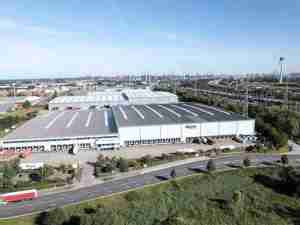The Port of Barcelona records its best ever half-year traffic figures
posted by AJOT | Jul 24 2017 at 01:42 PM | Ports & Terminals
Total progression of traffic (+18%) and containers (+27.2%) together with the new offer of maritime services indicate that the year is likely to close on a very positive note
The first six months of 2017 were the best first half year ever for the Port of Barcelona, with total traffic of 28.6 million tonnes of goods handled and an increase of 18% year on year. This result was due to the excellent behaviour of three traffic segments: containers (+27.2%), liquid bulk (+10.9%) and freight shipped by motorways of the sea (+7.2%).
In the first six months, the Port of Barcelona recorded container traffic of 1.3 million TEU (twenty- foot container units), an increase of 27.2% compared to the same period in 2016. The most notable increase occurred in transhipment containers, which rose by 101%. Full import and export containers continued their positive trend (up 4.5% and 4.7% respectively), after years of significant accumulated increases. It should be noted that for the first time import containers (276,529 TEU) this half year exceeded the pre-crisis record of 272,138 TEU achieved in 2007.
The president of the Port of Barcelona underlined the advantages of increased transhipment activity: “Although not related directly to our local economy, transhipment allows us to be more competitive in stowage operations, since we have a greater critical mass of freight. Furthermore, import and export companies benefit from the connectivity that these lines bring to reach new markets in more competitive conditions.”
New offer of regular services
Indeed, forecasts for the end of the year are very positive, due in part to the progression of traffic in these first months and to a new offer of services announced by shipping company MSC as of next week. It will provide five new sea lines connecting Barcelona with strategic destinations such as India, the United States, Canada and Brazil. At present, the Port has 46 regular container lines, which will increase to 51 with the incorporation of the five new MSC services.
Liquid bulk is the second type of traffic that has grown the most during the period. In this connection, the Port of Barcelona recorded a total 6.6 million tonnes of liquid bulk (+10.9%), which grew both in exports (+27%) and imports (+20%). One product that achieved the best results was natural gas (+32.5%) thanks to more being shipped into the Iberian Peninsula using maritime transport, to the detriment of gas pipelines.
Motorways of the sea increase
Regarding ro-ro traffic, the Port of Barcelona handled 199,906 intermodal transport units (ITU) during the first semester, an increase of 6.9 % year on year. Ro-ro traffic includes both cabotage (with the Balearic and Canary Islands) and traffic on the motorways of the sea connecting Barcelona with Italy (Civitavecchia, Genoa, Savona, Livorno and Porto Torres) and North Africa (Tangier, Tunisia and Nador). Specifically, the Port of Barcelona recorded 73,081 ITU on motorways of the sea and short sea shipping lines, marking a 7.2% increase over the first half of 2016. This result means that an identical number of trucks (more than 73,000) were diverted from roads to the maritime mode, which is more efficient both economically and environmentally.
Vehicle traffic figures up to June numbered 436,182 units, a decrease of 8.7%. Car traffic was particularly affected by stevedoring strikes, since manufacturers set up contingency plans to transport vehicles via alternative modes of maritime traffic, particularly for export flows. However, imports continued to increase at a rate of 5.6%.
With more than 2 million tonnes handled, dry bulk shipments continue to decline (-7%). This fall is due to lower exports of cement and clinker, related to the upturn in domestic housebuilding, and to imports of cereals and meal caused by the good harvest at national level the previous year. However, an increase in imports of cereals is forecast during the second half of the year.
As regards passengers, it should be noted that 1.57 million travellers (+5.3%) visited the Port of Barcelona during the first half year, either on board ferries or cruise ships. The amount of ferry passenger (with the Balearic Islands, Italy or North Africa) increased 12.4%, while cruise-goers increased 1.9%.
Economic results of the first half
During the first half of the year, the Port of Barcelona recorded net turnover of € 79.6 million, a year- on-year increase of 3.1% for the same period. Net profit for these first six months of the year stood at € 22.1 million, up 15.1% on the € 19.2 million profit for the same period in 2016. As regards generation of resources, operating cash flow for the half year was € 45 million, an increase of 3.9%.
Likewise, and thanks precisely to the capacity to generate own resources, the Port of Barcelona reduced a significant part of the long-term debt that it holds with the EIB. After drawing down € 43.6 million, the Port of Barcelona debt stands at € 303.9 million.









